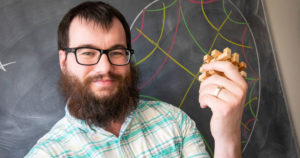Concrete is a universal building material, but it’s prone to wear, tear, and cracking over time. In addition to the main loading patterns, in large structures, deformations caused by temperature fluctuations—if not properly compensated for—can be a driving force of premature failure. To counteract that deformation, engineers usually design large structures to be assembled from lay it in large slabs. Those slabs are joined together with connection elements shielded from aggressive environments by a rubberized membrane, almost like caulk.
But, said Burns Healy, that connection element is expensive and concrete often fails at those joins.
“It would be much better if we could make larger monolithic pieces of concrete without joints rather than having to connect each of them,” he said.
That’s why Healy is teaming up with researchers from civil and environ-mental engineering professor Konstantin Sobolev’s group in the UWM College of Engineering and Applied Science. They’re trying to find new ways of shaping concrete through 3D printing that will increase its durability – and hopefully decrease its cost.
Healy is a visiting assistant professor in UWM’s Mathematical Sciences Department. He specializes in geometry and topology, the study of distance and shape. When civil engineering PhD student Aparna Deshmukh approached the math department looking for help in her project to create stronger concrete structures through 3D printing, Healy volunteered to collaborate.
A pattern to follow
It’s expensive to 3D print concrete, so instead of printing shapes and then testing what structural properties the finished product has, Healy is helping Deshmukh take a “math-up” approach by using modeling to understand what properties a finished product might have once it actually exists.
To do that, he’s examining existing research and determining what physical properties certain designs have once they’re created and printed. These properties include parameters like a Poisson’s ratio – a measure of the deformation of a material perpendicular to where pressure is applied – as an anisotropic strain, and if a material deforms more in one direction than another.
“The idea is to look at all of the systems that have been used so far … and say, these systems all have x, y, or z properties and this is how they work,” Healy explained. “If you want a certain property, look at the collection of systems that had that property. What, mathematically speaking, do those systems have in common that you can try to emulate?”
The designs that Healy is researching are made up of repeating patterns – think of the design of lines and rhombuses on sheet metal flooring, for example – and those patterns have different properties that affect the integrity of the concrete.
“What I noticed when I was being shown all of these (patterns) is that mathematically speaking, we understand all of them,” Healy said. “It turns out there are exactly 17 different kinds of patterns that these things can have, and these are called the wallpaper groups.”
Wallpaper groups are a way to classify repeating patterns, and mathematicians like Healy have long studied their characteristics.
“The question is, to what extent are values (like anisotropic strain and Poisson’s ratio) influenced by the wallpaper group associated to the pattern that it was modeled on? That’s what we’re trying to figure out,” he added.
Auxetic aesthetic
One of Deshmukh’s goals is to create auxetic concrete, so those properties are a fundamental piece of the building puzzle.
What does it mean to be auxetic?
“Imagine a mattress. If you push down hard enough, the sides will bulge out a little bit. … It’s a bad behavior for most materials to have for undergoing day-to-day anisotropic strain, like cars driving over asphalt,” Healy said. “This repetitive loading results in the fatigue of the material because it changes the geometry – specifically, the ratio between height and width. For long-term durability response, you would prefer that if you pushed it in, it would resist the expansion, contracting at the sides as well.
“That’s what it means to be auxetic. If you provide a positive force, you expand in all directions. If you provide an inward force, you contract in all directions.”
Auxetic materials maintain their structural integrity longer than non-auxetic materials. The catch is that materials aren’t naturally auxetic; instead, auxetic properties come from “meta materials,” or the way that a builder puts a material together.
For this project, Healy and Deshmukh are interested in finding the designs or systems that create the best auxetic material.
That’s where the wallpaper groups come in. Healy knows the properties of wallpaper groups. If he can apply what he knows about certain patterns based on their wallpaper group, he can better predict a pattern’s Poisson’s ratio, anisotropic strain, and other properties and determine if that pattern might make a good auxetic material.
The next steps
Healy is in the process of writing a paper examining the mathematics of the project, which he and his collaborators hope to use as a touchpoint to secure funding from the National Science Foundation. He estimates the paper will be completed later this month.
Healy also plans to examine systems in which patterns are self-repeating, like the beginnings of fractals.
In practice, creating an auxetic concrete could mean that buildings materials will be more structurally sound and last longer. And, Healy noted, as the world advances further into the space age, these materials will be essential in creating structures in environments without atmospheres – like a building on the moon.
After all, with a strong foundation, the sky’s the limit.
By Sarah Vickery, College of Letters & Science
